DMI – Graduate Course in Computer Science
Copyleft
![]() 2020 Giuseppe Scollo
2020 Giuseppe Scollo
outline:
model elements to be mapped to software: actors, queues, firing rules
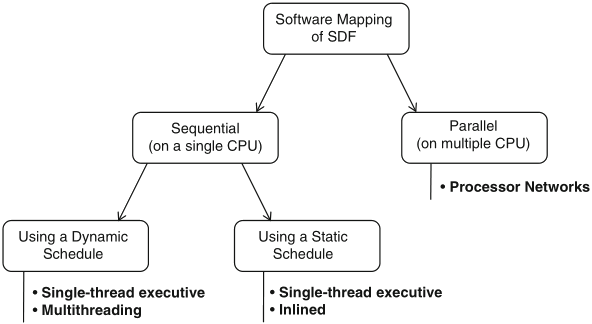
Schaumont, Figure 3.1 - Overview of possible approaches to map dataflow into software
parallel implementation, optimization of distribution of actors over the processors:
sequential implementation, options: scheduling, threading
FIFO queue, structure with:
it may be implemented as a circular array with two pointers to the access locations for the read and write operations, that are incremented mod N+1 if the array size is N+1, for a queue of size N
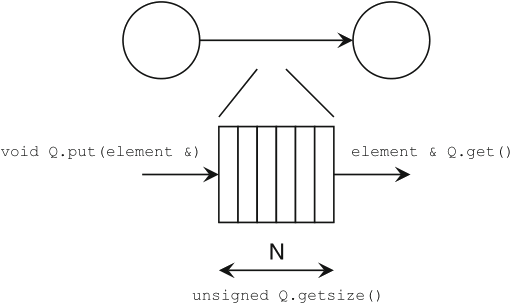
Schaumont, Figure 3.2 - A software queue
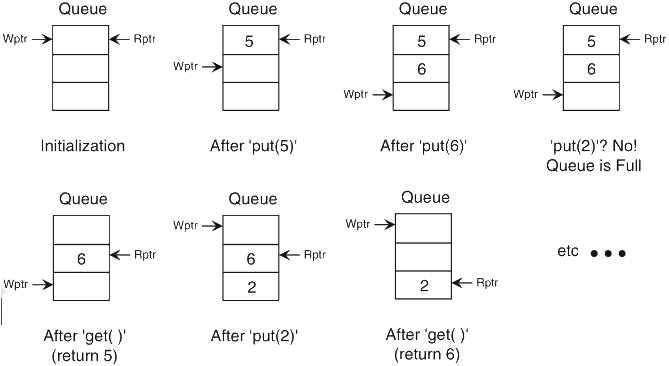
Schaumont, Figure 3.3 - Operation of the circular queue
#define MAXFIFO 8
typedef struct fifo {
int data[MAXFIFO]; // token storage
unsigned wptr; // write pointer
unsigned rptr; // read pointer
} fifo_t;
void init_fifo(fifo_t *F) {
F->wptr = F->rptr = 0;
}
void put_fifo(fifo_t *F, int d) {
if (((F->wptr + 1) % MAXFIFO) != F->rptr) {
F->data[F->wptr] = d;
F->wptr = (F->wptr + 1) % MAXFIFO;
}
}
int get_fifo(fifo_t *F) {
int r;
if (F->rptr != F->wptr) {
r = F->data[F->rptr];
F->rptr = (F->rptr + 1) % MAXFIFO;
return r;
}
return -1;
}
unsigned fifo_size(fifo_t *F) {
if (F->wptr >= F->rptr)
return F->wptr - F->rptr;
else
return MAXFIFO - (F->rptr - F->wptr);
}
int main() {
fifo_t F1;
init_fifo(&F1); // resets wptr, rptr;
put_fifo(&F1, 5); // enter 5
put_fifo(&F1, 6); // enter 6
printf("%d %d\n", fifo_size(&F1), get_fifo(&F1));
// prints: 2 5
printf("%d\n", fifo_size(&F1)); // prints: 1
}
Schaumont, Listing 3.1 - FIFO object in C
a C function, parameterized with a data structure to support I/O on the FIFO queues
a first, elementary example of FSM with datapath (FSMD):
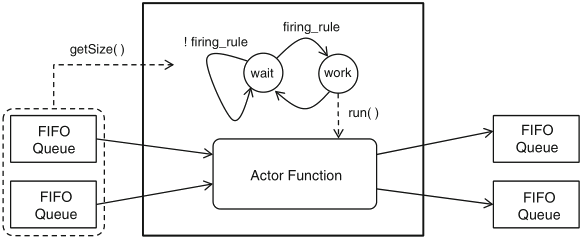
Schaumont, Figure 3.4 - Software implementation of the dataflow actor
a data structure to support up to eight input queues and as many output queues:
#define MAXIO 8
typedef struct actorio {
fifo_t *in[MAXIO];
fifo_t *out[MAXIO];
} actorio_t;
an actor which reads two integer tokens and produces their sum and their difference:
void fft2(actorio_t *g) {
int a, b;
if (fifo_size(g->in[0]) >= 2) {
a = get_fifo(g->in[0]);
b = get_fifo(g->in[0]);
put_fifo(g->out[0], a+b);
put_fifo(g->out[0], a-b);
}
}
with this arrangement, actors may be instantiated in the main program and invoked by dynamic scheduling
a dynamic system scheduler instantiates and initializes actors and queues, then it invokes the actors–say, in a round robin fashion:
void main() {
fifo_t q1, q2;
actorio_t fft2_io = {{&q1}, {&q2}};
..
init_fifo(&q1);
init_fifo(&q2);
..
while (1) {
fft2_actor(&fft2_io);
// .. call other actors
}
}

Schaumont, Figure 3.5a - A graph which will simulate under a single rate system schedule

Schaumont, Figure 3.5b - A graph which will cause extra tokens under a single rate schedule
system schedule
void main() {
..
while (1) {
src_actor(&src_io);
snk_actor(&snk_io);
}
}
a problem is apparent with the example in the second figure
solution 1: adjust system schedule
void main() {
..
while (1) {
src_actor(&src_io);
snk_actor(&snk_io);
snk_actor(&snk_io);
}
}
solution 2: adjust actor snk code
void snk_actor(actorio_t *g) {
int r1, r2;
while ((fifo_size(g->in[0]) > 0)) {
r1 = get_fifo(g->in[0]);
... // do processing
}
}
the fast (discrete) Fourier transform is widely used in signal processing
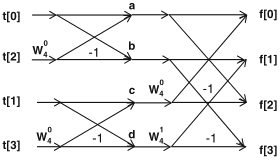
Schaumont, Figure 3.6a - Flow diagram for a four-point Fast Fourier Transform
a = t[0] + W(0,4) * t[2] = t[0] + t[2]
b = t[0] - W(0,4) * t[2] = t[0] - t[2]
c = t[1] + W(0,4) * t[3] = t[1] + t[3]
d = t[1] - W(0,4) * t[3] = t[1] - t[3]
f[0] = a + W(0,4) * c = a + c
f[1] = b + W(1,4) * d = b - j.d
f[2] = a - W(0,4) * c = a - c
f[3] = b - W(1,4) * d = b + j.d
an SDF model for the magnitude computation in the frequency domain:

Schaumont, Figure 3.7 - Synchronous dataflow diagram for a four-point Fast Fourier Transform
void reorder(actorio_t *g) {
int v0, v1, v2, v3;
while (fifo_size(g->in[0]) >= 4) {
v0 = get_fifo(g->in[0]);
v1 = get_fifo(g->in[0]);
v2 = get_fifo(g->in[0]);
v3 = get_fifo(g->in[0]);
put_fifo(g->out[0], v0);
put_fifo(g->out[0], v2);
put_fifo(g->out[0], v1);
put_fifo(g->out[0], v3);
}
}
void fft2(actorio_t *g) {
int a, b;
while (fifo_size(g->in[0]) >= 2) {
a = get_fifo(g->in[0]);
b = get_fifo(g->in[0]);
put_fifo(g->out[0], a+b);
put_fifo(g->out[0], a-b);
}
}
void fft4mag(actorio_t *g) {
int a, b, c, d;
while (fifo_size(g->in[0]) >= 4) {
a = get_fifo(g->in[0]);
b = get_fifo(g->in[0]);
c = get_fifo(g->in[0]);
d = get_fifo(g->in[0]);
put_fifo(g->out[0], (a+c)*(a+c));
put_fifo(g->out[0], b*b - d*d);
put_fifo(g->out[0], (a-c)*(a-c));
put_fifo(g->out[0], b*b - d*d);
}
}
int main() {
fifo_t q1, q2, q3, q4;
actorio_t reorder_io = {{&q1}, {&q2}};
actorio_t fft2_io = {{&q2}, {&q3}};
actorio_t fft4_io = {{&q3}, {&q4}};
init_fifo(&q1);
init_fifo(&q2);
init_fifo(&q3);
init_fifo(&q4);
// test vector fft([1 1 1 1])
put_fifo(&q1, 1);
put_fifo(&q1, 1);
put_fifo(&q1, 1);
put_fifo(&q1, 1);
// test vector fft([1 1 1 0])
put_fifo(&q1, 1);
put_fifo(&q1, 1);
put_fifo(&q1, 1);
put_fifo(&q1, 0);
while (1) {
reorder(&reorder_io);
fft2 (&fft2_io);
fft4mag(&fft4_io);
}
return 0;
}
Schaumont, Listing 3.2 - 4-point FFT as an SDF system
with multithreading, dynamic scheduling is implemented by assigning each actor its own thread of execution
often: round-robin scheduler + solution 2 seen earlier
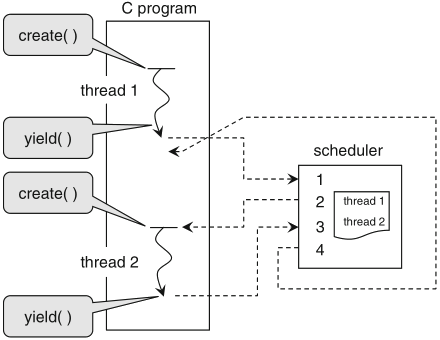
Schaumont, Figure 3.8 - Example of cooperative multi-threading
QuickThreads library functions:
control release with stp_yield() keeps local variables throughout subsequent runs
#include "../qt/stp.h"
#include <stdio.h>
void hello(void *null) {
int n = 3;
while (n-- > 0) {
printf("hello\n");
stp_yield();
}
}
void world(void *null) {
int n = 5;
while (n-- > 0) {
printf("world\n");
stp_yield();
}
}
int main(int argc, char **argv) {
stp_init();
stp_create(hello, 0);
stp_create(world, 0);
stp_start();
return 0;
}
application of this technique to the example developed in Listing 3.2 is very simple, e.g. for actor fft2:
void fft2(actorio_t *g) {
int a, b;
while (1) {
while (fifo_size(g->in[0]) >= 2) {
a = get_fifo(g->in[0]);
b = get_fifo(g->in[0]);
put_fifo(g->out[0], a+b);
put_fifo(g->out[0], a-b);
}
stp_yield();
}
}
int main() {
fifo_t q1, q2;
actorio_t fft2_io = {{&q1}, {&q2}};
...
stp_create(fft2, &fft2_io); // create thread
...
stp_start(); // run the schedule
}
static scheduling allows optimization of a software implementation in three respects:
example:
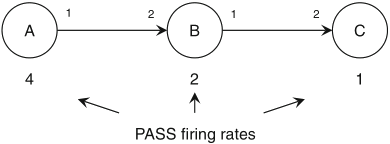
while(1) {
// call A four times
A(); A(); A(); A();
// call B two times
B(); B();
// call C one time
C();
}
Schaumont, Figure 3.9 - System schedule for a multirate SDF graph
the static schedule in the figure is a PASS, yet it is not optimal for the minimization of the capacity of the queues: the firing sequence (A, A, B, A, A, B, C) is optimal
optimized implementation of the FFT4 model on p. 9 with static schedule and inlining:
void dfsystem(int in0, in1, in2, in3, *out0, *out1, *out2, *out3) {
int reorder_out0, reorder_out1, reorder_out2, reorder_out3;
int fft2_0_out0, fft2_0_out1, fft2_1_out0, fft2_1_out1;
int fft4mag_out0, fft4mag_out1, fft4mag_out2, fft4mag_out3;
reorder_out0 = in0;
reorder_out1 = in2;
reorder_out2 = in1;
reorder_out3 = in3;
fft2_0_out0 = reorder_out0 + reorder_out1;
fft2_0_out1 = reorder_out0 - reorder_out1;
fft2_1_out0 = reorder_out2 + reorder_out3;
fft2_1_out1 = reorder_out2 - reorder_out3;
out0 = fft4mag_out0 =
(fft2_0_out0 + fft2_1_out0) * (fft2_0_out0 + fft2_1_out0);
out1 = fft4mag_out1 =
fft2_0_out1*fft2_0_out1 - fft2_1_out1*fft2_1_out1;
out2 = ftt4mag_out2 =
(fft2_0_out0 - fft2_1_out0) * (fft2_0_out0 - fft2_1_out0);
out3 = fft4mag_out3 =
fft2_0_out1*fft2_0_out1 - fft2_1_out1*fft2_1_out1;
}
Schaumont, Listing 3.4 - Inlined data flow system for the four-point FFT
recommended readings:
for further consultation: